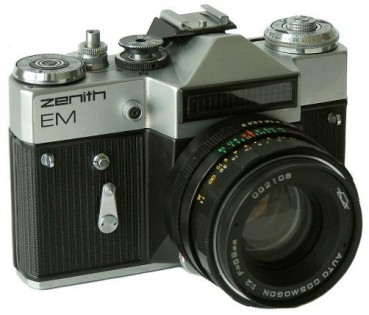Interesting that so many people have suggested so many 'high-end' cameras; apart from the immortal brownie, and the enthusiasts Trip. But where did we all start?
Two unsung heros's for you to consider:-
The Konika C35. It was not revolutionary, nor evolutionary. It wasn't particularly sophisticted; but... when I was a kid... this was the camera every-one was snapping with.
Grandad, was 'farting about' with a Kodak Retinet, waving a light meter around, and getting frustrated with the range-finder, hunting for a tape-measure, doing anything and everything BUT take a photograph...
My dad was getting all pretentiouse, with a Pentax...
And there was my auntie, using her hubbies Konika... "Its simple darling; just point and press.... just remember to take the lens cap of first...."
It was one of the first mass produced electronic shutter instamatics offered at a mass market price, and it got people taking pictures, and pretty good ones..... when they remembered to remove the lens cap!
So enter it's successor...
The Olympus XA2. It solved the lens cap issue with its award winning 'slide'; a feature so many cameras adopted in the years that followed! Its much vaunted sales feature was it used the same off-the-film metering system as the then vaunted OM series SLR's. It was small and compact; easy to carry, easy to use, and while the dedicated detacheable flash made it a bit more bulky, did hint towards fully integrated flashes.
I was given one by my Dad for my 10th birthday, in 1980. I had the choice between that and a Pentax 110 SLR, and while the Pentax now may have novelty value; that little Olympus has delivered, and delivered, and delivered. For twenty years, that little camera went almost every where I did. It's bashed and battered, and ten years ago I realised that the occassional bit of flare I was getting was actually the lens coating disintegrating, but its had more meters of film pass through it than any other camera I have ever owned... which makes it a 'great' camera to ME.... but for the same twenty years, it set the standard for a compact camera; and SO many people, particularly women, uninterested in fiddling with dials and buttons, got into photography using one, to take pictures that were, pretty impressive for such a little camera.
Two more?
The Russian Zenit and East-German Praktica, Pentax copies. The Praktica's even got Through The lens light metering! Not sure the Zenits ever did, but still! You used to be able to buy a Praktica 'Kit' in Dixons, with about three lenses, a flash, and a guide to SLR photography, all in a profesional looking aluminium case, for about £50, when my Olympus XA was almost twice that!
Simple, unsophisticated, rather err... clunky, and old fashioned, they were, like the two compacts, neither revolutionary, nor evolutionary. They were... cheap. But for so many a school-boy, they were a christmas present that introduced them to the persuit. For so many grown-ups starting out, they were the toe in the water, that got them going.
Might not be cameras we would aspire to; not cameras we would normally applaud; but for so many they WERE the camera they took pictures with!
End of the day, photo's are taken to get pictures, pictures for people to look at. They aren't really interested in what took them, only whether they are 'interesting'. And you cant get an interesting photo unless you have a photo, and you cant get a photo without a camera, so these, humble cameras that did THAT and got SO many pictures that other wise just wouldn;t have been taken? I think that gives them some measure of greatness.
Oh... hi, btw... I'm Mike & I've just joined. And from Warwichshire. That bit of Britain in the middle neither you northern monekeys nor southern pansies wish to include in your domanse! & signing in, having just aquired my first DSLR, and trying to work out HTF to get a RAW image out of it onto the puter, and why, it says NEF not RAW!?!?!? I'm sure I'll figure it.... at some point! Hey! Its cheaper than buying film! So far that's one of the few plus points I ca find for it... whether I'll find any more I dont know.


 . Do think that the F3 looks better with a DE2 compared to a DE3 viewfinder mind.
. Do think that the F3 looks better with a DE2 compared to a DE3 viewfinder mind.


